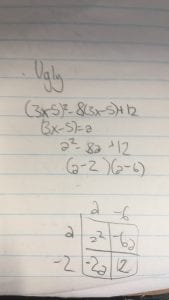Pre-Calc 11 Week #7
This week I learned about the zero product law and how in a quadratic equation that = 0 we must make the x value be a opposite congruent of the other number in a factored binomial.
Basically after you have factored an equation and received an answer such as (x+2)(x+3)=0
The x value must be equal to the opposite of the number its adding to so the binomial equals 0
In that case the x would be equal to -2 so the -2 and +2 cancel out, the other x value would do the same with its binomial so it would be equal to -3 so the -3 and +3 cancel out and the equation = 0
In this example I will show how to do it from factoring to solving what x must be for it to equal 0
Pre-Calc 11 Week #6
This week we learned how to use the quadratic formula and when we should.
In this example I show when we should use the quadratic formula (the first step is to find the discriminant using the formula in the example)
With a discriminant of +24 we know it has 2 roots
if the discriminant was 0 it would have 1 root and if it was negative it would have no root meaning it is unfactorable
In this next example I use the quadratic formula to find an exact answer
With this answer I can then simplify by simplifying the radical and then dividing by a common number in this case 2
Pre-Calc 11 Week #5
This week in Pre-Calc 11 we started learning how to factor and simplify, we learned how to do this using Punnett Squares and using the acronym CDPEU to mean Common, Difference, Pattern, Easy and Ugly respectively. Using CDPEU means looking for what’s common, a difference of squares, a pattern within and if it’s easy or ugly In this example I show how it can be common or how it could be a difference of squares 
In this next example I show how to simplify when it’s ugly



